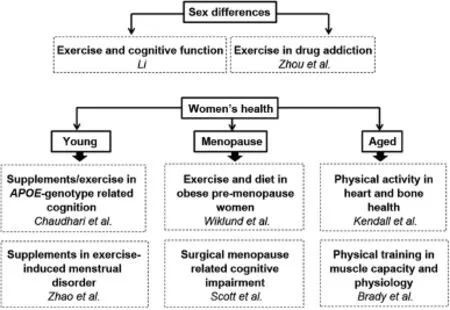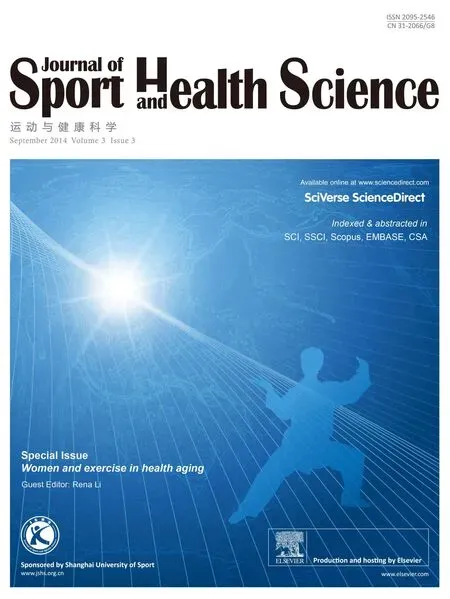Women’s health in exercise and aging:What do we know?
Editorial
Women’s health in exercise and aging:What do we know?
Recent articles published inNaturepointout how sex bias, primarily concerning male-exclusivity,in biological research resultin misleading and ambiguous science.1—4Forexample,the majority of animal studies published in academ ic journals used only males,while only very limited studies were investigated in females or both sexes.The consequences of such male-favored sex bias in biomedical studies had lead to a huge cost in the biomedicalindustry including drug development.Between 1997 and 2001,eightoutof10 prescription drugswere w ithdrawn from the marketby the US FDA because they showed more side effects for women than men,1,2,5—8since there are no sex-based equal opportunity requirementsforphase IIclinicaltrials.Indeed,many scientific foundations and professional journals have started to request sex justifications for research grants and manuscript publications due to the high prevalence in male-favored participant research.9—11Equal opportunity sex-based analysis in research willnotonly save us from errors,butalso lead to new discoveries for better treatments,prevention of disease,and developing sex-specific approaches in public health related applications.
Sex differences in exercise have been well documented in both human and animal studies.While extensive literature showed that the sex differences in learning and memory started from an early stage ofneuronaldevelopmentand laststhrough an entire lifespan,little is known about how much sex-based biology contributes to elite athletes in various sports.In this specialissueofWomen and Exercisein Health Aging forJournal ofSportand Health Science(JSHS),we have included a totalof eightarticles.Among these,there are four review articles12—15and four original research reports16—19that covered two major topics:(1)sex differences in brain functions,and(2)exerciseand age-related women’s health as shown in Fig.1.
In this special review by Dr.Li12from the Roskamp Institute,USA,a comprehensive overview of the sex differences in brain function and cognitive activities are presented. In the review article,she not only included biological mechanisms of male-and female-type cognitive behaviors in young and old individuals,butalso highlighted the role of sex-favor learning and memory behaviors in sports.Furthermore,w ith growing literature in exercise as an effective prevention and treatment option for drug addiction,Dr.Zhou and his colleagues13from Shanghai University of Sport,China,highlighted the importance of sex differences in drug abuse and effectiveness of exercise intervention in a review article w ith more than 100 cited publications.We hope these two review articles w ill deliver an important message stating that sex plays a significant role in our life whether in normal healthy individuals,elite athletes,or individuals w ith physical/mental disorders.
A major topic in this special issue is exercise and aging in women with a total of six manuscripts covering studies of females atyoung/adult,menopausal,and old ages.Dr.Zhao and her colleagues16from Shanghai University of Sport,China, investigated theeffectofenergy intakeon prevention ofexerciseassociated menstrualdysfunction in young adult female ratsand showed thatglucose and oligosaccharide intake can normalize the menstrual cycle by restoring the follicular subcellular structure,and reversed the exercise-induced reduction of ovary sex hormones in rats.Moreover,Dr.Chaudhari and her colleagues17from University ofNorth TexasHealth Science Center, USA,have studies show ing that antioxidant supplementation, moderate exercise,or the combination of both treatments could ameliorate cognitive performance in young adult m ice and the apolipoprotein(APOE)genotype,as wellassex,could influence the functional outcomes of the treatments.In conclusion,they found thatexercisewasthemosteffectivetreatmentin improving cognitive function in both genotypesand sex,while antioxidants seemed to be effective only in theAPOE4.
There has been an increase in research pertaining to health concerns in menopause as well.Studies showed that prematurely menopausalwomen mighthave higher risks of dementia and other neurological diseases.20In this issue,we have also included an original research article by Dr.Scott and her colleagues18from Georgia Regents University,USA, regarding discovery of the critical role of brain estrogen in early surgical menopause females.Their studies not only partially explained the enhanced risk of dementia and mortality from neurological disorders in prematurely menopausal women,but also timely initiation of estrogen therapy to yield maximum neurological benefi t,another age-related health issue is obesity in women.Research reported by Dr.Wiklund and her colleagues19from University of Jyva¨skyla¨,Finland,investigated effects of weight loss and regular aerobic exercise on energy metabolism in pre-menopausal women.They demonstrated that small weight loss does not produce measurable health benefi ts in obese women.However,shortterm regular aerobic exercise can improve glucose and lipid metabolism.

Fig.1.A summary of research topics in the special issue of Women and Exercise in Health Aging.
Aging is associated w ith physiological declines,notably a decrease in bone m ineral density and lean body mass,w ith a concurrent increase in body fat,and central adiposity.While physicalactivity haslong been associated w ith the attenuation of age-associated physical decline,Drs.Kendall14from Georgia Southern University,USA,and Brady15from University ofNorth Carolina,USA,provided excellent reviews on how to maintain adequate levels of physical activity or physical training during aging to increase longevity and reduce risk for age-related chronic diseases,specific to women based on current research.
In summary,we have included the publications with focus of sex differences in brain function and women’s health research around the world.I hope these outstanding articles can promote an awareness of sex-specific impact in biology and behavioralscience and trigger further investigation of sexspecific research in public health,particularly for women.
1.Schiebinger L.Scientifi c research must take gender into account.Nature2014;507:9.
2.Pollitzer E.Cell sex matters.Nature2013;500:23—4.
3.Gove A.A forgotten history of sex research.Nature2013;501:167.
4.Tilley L,M cConville M.Sensing when it’s time for sex.Nature2013;499:38—40.
5.Kernan WN,Viscoli CM,Brass LM,Broderick JP,Brott T,Feldmann E, et al.Phenylpropanolam ine and the risk of hemorrhagic stroke.N Engl J Med2000;343:1826—32.
6.Connolly HM,Crary JL,M cGoon MD,Hensrud DD,Edwards BS, Edwards WD,et al.Valvular heart disease associated w ith fenfluram inephenterm ine.N Engl J Med1997;337:581—8.
7.Graham DJ,Green L.Further cases of valvular heart disease associated w ith fenfluramine-phentermine.N Engl J Med1997;337:635.
8.Kohlroser J,Mathai J,Reichheld J,Banner BF,Bonkovsky HL.Hepatotoxicity due to troglitazone:report of two cases and review of adverse events reported to the United States Food and Drug Adm inistration.Am J Gastroenterol2000;95:272—6.
9.Greenspan JD,Craft RM,LeResche L,Arendt-Nielsen L,Berkley KJ, Fillingim RB,et al.Studying sex and gender differences in pain and analgesia:a consensus report.Pain2007;132(Suppl.1):S26—45.
10.Blaustein JD.Animals have a sex,and so should titles and methods sections of articles in Endocrinology.Endocrinology2012;153:2539—40.
11.Gillies GE,M cArthur S.Estrogen actions in the brain and the basis for differential action in men and women:a case for sex-specific medicines.Pharmacol Rev2010;62:155—98.
12.Li R.Why women see differently from the way men see?A review of sex differences in cognition and sports.J Sport Health Sci2014;3:155—62.
13.Zhou Y,Zhou C,Li R.Sex differences in exercise and drug addiction:a mini review of animal studies.J Sport Health Sci2014;3:163—9.
14.Kendall KL,Fairman CM.Women and exercise in aging.J Sport Health Sci2014;3:170—8.
15.Brady AO,Straight CR.Muscle capacity and physical function in older women:what are the impacts of resistance training?J Sport Health Sci2014;3:179—88.
16.Zhao C,Liu XL,Hong RX,LiH,LiR,Wang RW.Effects of carbohydrate supplements on exercise-induced menstrual dysfunction and ovarian subcellular structural changes in rats.J Sport Health Sci2014;3:189—95.
17.Chaudhari K,Wong JM,Vann PH,Sum ien N.Exercise training and antioxidant supplementation independently improve cognitive function in adult male and female GFAP-APOEm ice.J Sport Health Sci2014;3:196—205.
18.Scott EL,Zhang QG,Dong Y,Han D,Wang RM,Vadlamudi RK,et al. Surgical menopause enhances hippocampal amyloidogenesis follow ing global cerebral ischem ia.J Sport Health Sci2014;3:206—16.
19.W iklund P,A len M,Munukka E,Cheng SM,Yu B,Pekkala S,et al. Metabolic response to 6-week aerobic exercise training and dieting in previously sedentary overweight and obese pre-menopausal women:a random ized trial.J Sport Health Sci2014;3:217—24.
20.Rocca WA,Bower JH,Maraganore DM,Ahlskog JE,Grossardt BR,de Andrade M,et al.Increased risk of cognitive impairment or dementia in women who underwent oophorectomy before menopause.Neurology2007;69:1074—83.
Rena Li,Guest Editor
Center for Hormone Advanced Science and Education, Roskamp Institute,Sarasota,FL 34243,USA
E-mail address:rli@rfdn.org
13 June 2014
Peer review under responsibility of Shanghai University of Sport
2095-2546/$-see front matter CopyrightⒸ2014,Shanghai University of Sport.Production and hosting by Elsevier B.V.A ll rights reserved. http://dx.doi.org/10.1016/j.jshs.2014.06.001
 Journal of Sport and Health Science2014年3期
Journal of Sport and Health Science2014年3期
- Journal of Sport and Health Science的其它文章
- Why women see differently from the way men see?A review of sex differences in cognition and sports
- Sex differences in exercise and drug addiction:A m ini review of animal studies
- Women and exercise in aging
- Effects of carbohydrate supplements on exercise-induced menstrual dysfunction and ovarian subcellular structural changes in rats
- Exercise training and antioxidant supplementation independently improve cognitive function in adult male and female GFAP-APOE m ice
- Surgical menopause enhances hippocampal amyloidogenesis follow ing global cerebral ischem ia
